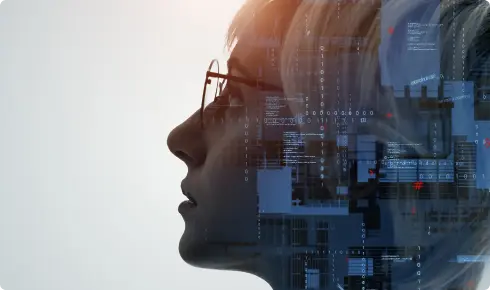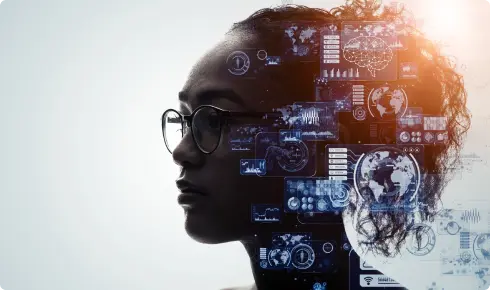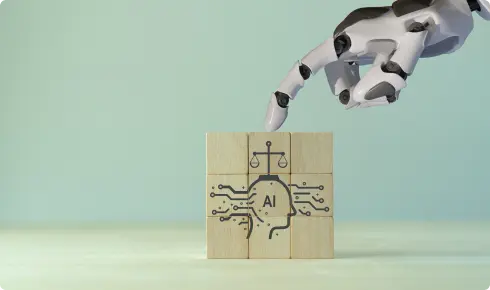
Resetting collaboration in a changing world.
If you’re fretting about the purported threat from artificial intelligence to how humans work together, be sure to raise the issue during your next PowerPoint presentation or email composition. If you get the implicit irony in that suggestion, you can follow it by treating yourself to an enormous sigh of relief.
For those still puzzled, here’s the kicker: PowerPoint incorporates many elements of machine learning and AI engineering. The ubiquitous presentation program – together with other regularly used software tools (think Adobe, and various other mobile apps) use AI algorithms to save time while selecting templates, images, and other materials, so the user can maintain their focus on the presentation’s primary themes.
This example also illustrates one of the many potential benefits as machine language and AI assumes an ever-growing role in the way humans collaborate with one another – even to the point of reinventing and improving the very nature of collaboration.
This isn’t simply a matter of people collaborating with AI (although that’s a significant topic unto itself), t’s the inherent possibilities of people leveraging artificial intelligence to better collaborate with other human beings. In short, it’s time for us to reset.
Cross-boundary collaboration defined
If, as many authorities are telling us, collaboration is growing ever more critical to work and society, cross-boundary collaboration stands as an even greater tipping point between those who succeed with innovation and others who struggle to keep up.
What exactly do we mean by ‘cross-boundary collaboration’? It is conventional collaboration that’s been taken further. Defined simply, cross-boundary collaboration defines an environment in which ideas are genuinely celebrated and all suggestions and ideas are welcomed. So, too, is the source of that input broad and varied; anyone is invited to contribute, regardless of their position or group, both inside and outside an organization.
It doesn’t take a great deal of imagination to see that’s the sort of setting where innovation flourishes – the sort of game-changing ideas and vision that can transform entire organizations and even industries. Even more important, it’s a setting where sustained innovation takes place; the capacity to replicate the innovation process over and over, consistently producing viable, exciting results.
Cross-boundary collaboration defines an environment in which ideas are genuinely celebrated and all suggestions and ideas are welcomed.
The future depends on collaboration
Whether we recognize it or not, collaboration is growing ever more critical to work and society. As Texas A&M University Human Resource Development professor Michael Beyerlein points out, the essential value of collaboration incorporates three primary driving factors:
- Group intelligence: As challenges and problems become increasingly complex, so does the significance of multiple stakeholders pooling their strengths to devise viable solutions.
- Learning: Whether at home or on the job, humans are charged with learning faster, more comprehensively and from a growing number of sources.
- Goal alignment: By positioning objectives as complementary rather than competitive, common benefits can be achieved instead of succeeding at someone or something else’s expense. Greater benefit for all is the result.
In short, we are very much all in this together. And, in an environment characterized by exponential change that’s taking hold at an accelerating rate, our capacity to unite and work as one will prove critical to leveraging that change rather than struggling with it.
Two great human-human cross-collaborations
- In the Netherlands in 2015, the national police and the public prosecutor’s office joined forces to crack down on organized crime and convened dozens of interdisciplinary professionals. One group of five members was assigned to the issue of illegal marijuana-growing houses in residences in the city of Breda. The group included representatives from city police, a tax office, a power utility, and municipal public safety and security, as well as a public prosecutor.
- AP Thai, a major Thai real estate development company, oversaw projects centered on the design of large new condominium buildings and involved the input of architectural, sales and marketing, supply chain, legal, financial, and other specialists. Rather than encountering strong conflicts, participants helped others to translate their ideas, understand one another, and find ways to modify and alter ideas so that they could merge and come together where possible.
“Whether we recognize it or not, collaboration is growing ever more critical to work and society.”
The Role of personas
Effective cross-boundary collaboration doesn’t hinge just on a welcoming environment – however important that might be. A diversity of input is equally critical; an array of perspectives, ideas, and vision contributed to by a variety of different people and sources.
Successful innovation depends on input from a wide range of people in collaboration: sharing ideas, comparing observations, offering wide-ranging perspectives from their diverse viewpoints, and brainstorming solutions to complex problems. We refer to these divergent perspectives as personas. Here are a few examples, as defined in our previous work innovation:
- Learning personas keep an enterprise from being too internally focused and caught in their comfort zone.
- Organizing personas move the innovation lifecycle forward; they are skilled at navigating processes, politics, and red tape to bring an innovation to market.
- Building personas are the closest to innovative action, establishing connections between the learning and organizing personas. They apply insights from the learning personas and channel empowerment from the organizing personas to facilitate innovation.
As you can see, the greater the number and variety of personas, the more productive and rewarding the overall process. Equally obvious is the potential caveat of limitations. The fewer the participating personas, the less the potential for compelling innovation.
AI Steps into the collaborative breach
The solution, boiled down, is relatively straightforward. Do you need more or different personas to help drive cross-collaborative innovation? AI could be a significant value-add.
AI-generated personas can be seen as digital characters or personas that can effectively augment/replicate a human persona. While these can be used in a variety of applications – including research, design, strategy, and other tasks – personas can also participate in cross-boundary collaboration, effectively adding fresh observations and analysis to the overall conversation.
One powerful advantage to AI personas is the breadth of their DNA. AI personas can be based on a broad swath of demographic factors, industry data, market research, and other information. While human personas may be rather limited as to the source of their input, AI personas have the inherent capacity to be much more broadly grounded.
The process with which an AI persona is used can be similarly straightforward. After introducing input from others involved in cross-boundary discussion and examination, AI can quickly examine all the material in play to offer additional analysis and exploration.
Like other uses of AI, the advantage to AI-generated personas is speed. AI review and analysis can take place in a fraction of the time required by its human counterparts. In a shifting environment where things are changing more often and faster than ever before, the capacity for quick, accurate analysis can prove a powerful ace in the hole.
Although concerns about bias are genuine and need to be addressed, AI nonetheless can be an effective tool in arriving at decisions and solutions in a highly empirical manner. That information, in effect, can make humans better cross-collaborators – more informed, with higher quality data and other material with which to work together with others. That leads to better human-driven outcomes.
Even better, AI-generated personas are not cast in stone. Once created, the AI persona can be revised and retrained as new data and insights emerge. This ensures that the persona’s input and participation remain aligned with shifting market conditions, organizational goals, and other elements that are subject to change.
Researchers determined that companies using AI to effectively replace human workers only reaped short-term benefits.
Humans are no less important
It’s helpful to bear in mind that he purported “threat” of AI taking control rather than collaborating is hardly new, particularly in popular culture. Frankenstein was published in 1818. Roughly a century later, a Czech play titled R.U.R. (Rossumovi Univerzální Roboti) portrayed robots rebelling and slaughtering most of their human “masters”. And on up through 2001: A Space Odyssey’s Hal (“What are you doing, Dave?”), Transformers – here, robots are divided among do-gooders and n’er – do wells – up to more positive castings, such as the ever helpful J.A.R.V.I.S. which serves as Tony Stark’s invaluable right hand man in the Iron Man movie series.
Although the topic of AI as a whole can still drive many people to reach for a paper bag in which to breathe, AI-generated personas are not geared to replacing human participants. Rather, they’re in place to augment and strengthen the entire process. While AI can be fast and empirical, empathy is simply a factor that – so far, at least – cannot be inputted into the guts of AI. That, happily, remains the sole purview of human beings, which is what makes the AI/human cross-collaborative process both balanced and potentially very prolific.
Moreover, everything simply seems to function so much better when humans and AI collaborate. According to comprehensive research by Accenture involving some 1,500 companies, researchers determined that companies using AI to effectively replace human workers only reaped short-term benefits. On the other hand, those that partnered AI with human personnel achieved the greatest results by enhancing each other’s strengths – human leadership and creativity coupled with AI’s quantitative power and speed.
It’s becoming increasingly clear that innovation is not a take it or leave it option. Rather, it’s essential for any enterprise moving forward. Cross-boundary collaborative teams, working with enabling technologies such as AI-generated personas, can power meaningful, sustained innovation.
Two great human-AI cross-collaborations
- An example of AI to identify cross boundary collaborative data. GNS Healthcare applies machine-learning software to find overlooked relationships among data in patients’ health records and elsewhere. After identifying a relationship, the software churns out numerous hypotheses to explain it and then suggests which of those are the most likely. This approach enabled GNS to uncover a new drug interaction hidden in unstructured patient notes.
- Ninjacart, India’s largest B2B fresh produce supply chain platform company, first deployed a conversational AI solution over WhatsApp to reach out to its clientele with updates and resolve any major queries. However, the queries that were then transferred to agents took a lot of time to resolve, thus affecting their customer satisfaction score. They brought on generative AI power for their agents so they could resolve any incoming queries faster, which led to an improvement of their CSAT score by more than 11%.
Originally published on IbyIMD.
Related: 5 ways to kick bad habits by Faisal Hoque
Copyright (c) 2024 by Faisal Hoque. All rights reserved.















